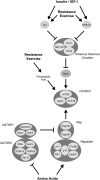Integration of signals generated by nutrients, hormones, and exercise in skeletal muscle
- PMID: 24284445
- PMCID: PMC3862457
- DOI: 10.3945/ajcn.113.068387
Integration of signals generated by nutrients, hormones, and exercise in skeletal muscle
Abstract
This review focuses on anabolic signaling pathways through which insulin, amino acids, and resistance exercise act to regulate the protein kinase complex referred to as mechanistic target of rapamycin complex (mTORC) 1. Initially, individual pathways through which the 3 anabolic signals act to modulate mTORC1 signaling will be discussed, followed by a summation of evidence showing an additive effect of the regulators. The emphasis will be on mTORC1 signaling in skeletal muscle and its contribution to modulation of rates of protein synthesis. In addition, results from studies using cells in culture will be used to provide a more complete picture of the molecular details of the individual pathways.
Figures


References
-
- Bracho-Valdés I, Moreno-Alvarez P, Valencia-Martinez I, Robles-Molina E, Chavez-Vargas L, Vazquez-Prado J. mTORC1- and mTORC2-interacting proteins keep their multifunctional partners focused. IUBMB Life 2011;63:896–914. - PubMed
-
- Dempsey JM, Mahoney SJ, Blenis J. mTORC1-mediated control of protein translation. In: Fuyuhiko T, Michael NH, eds. The enzymes. Waltham, MA: Academic Press, 2010:1–20.
-
- Marcotrigiano J, Gingras A-C, Sonenberg N, Burley SK. Cap-dependent translation initiation in eukaryotes is regulated by a molecular mimic of eIF4G. Mol Cell 1999;3:707–16. - PubMed
-
- Holz MK, Blenis J. Identification of S6K1 as a novel mTOR-phosphorylating kinase. J Biol Chem 2005;280:26089–93. - PubMed
Publication types
MeSH terms
Substances
Grants and funding
LinkOut - more resources
Full Text Sources
Other Literature Sources
Medical

